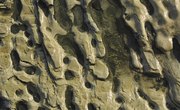
The three major forms of fossil fuels -- coal, oil and natural gas -- were formed during the Carboniferous Period, which gets its name from carbon, a common element found in all fossil fuels. They formed from organic remains of plants and animals that were converted into coal, oil or natural gas by exposure to heat and the pressure of the Earth’s crust over millions of years. The organic root of fossil fuels explains the presence of carbon, but other elements, such as hydrogen, sulfur, nitrogen and oxygen are also components of fossil fuels.
Coal
According to the Penn State College of Earth and Mineral Sciences, coal is composed of carbon, hydrogen, nitrogen, sulfur and oxygen. There are three types of coal, each of which has its own chemical composition. Anthracite has the most carbon, while lignite is the lowest in carbon, but highest in hydrogen and oxygen. The content of bituminous coal is in between anthracite and lignite. Coal also has some mineral content, which is commonly quartz, pyrite, clay minerals and calcite. Elements like iron and zinc that remain in the peat, or layers of decomposed plants, which eventually forms into coal, might combine to create these minerals.
Natural Gas
Like coal, natural gas is made up of carbon, hydrogen, nitrogen, sulfur and oxygen. It does not have mineral content like coal, and instead of a hard, black substance, natural gas is lighter than air, according to the California Energy Commission. It has no odor and you cannot see it, and it is found near underground petroleum. The carbon and hydrogen elements in natural gas typically combine to form methane gas, or CH4, which is highly flammable.
Oil
Oil, or petroleum, also consists of carbon, hydrogen, sulfur, oxygen and nitrogen, but it is in liquid form. Both oil and natural gas are found underground between folds of rocks or inside porous rocks that hold the oil. When diatoms, sea creatures like phytoplankton, die and fall to the sea floor, they are eventually buried in sediment and rock. Under great pressure and heat, these layers of diatoms become oil or natural gas. If conditions are too hot, the oil is more likely to become gas. Oil is mined and then refined into gasoline, kerosene or other products.
Combustion
Combustion occurs when fossil fuels are burned, and the elements in the fossil fuels oxidize, or combine with oxygen. When coal is burned, the carbon oxidizes to form carbon dioxide, or CO2. Similarly, nitrogen becomes nitrous oxide, or NO2, and sulfur becomes sulfur dioxide, or SO2. The mineral content found in coal and oil become ash.
References
About the Author
Cara Batema is a musician, teacher and writer who specializes in early childhood, special needs and psychology. Since 2010, Batema has been an active writer in the fields of education, parenting, science and health. She holds a bachelor's degree in music therapy and creative writing.
Photo Credits
Jeffrey Hamilton/Digital Vision/Getty Images
